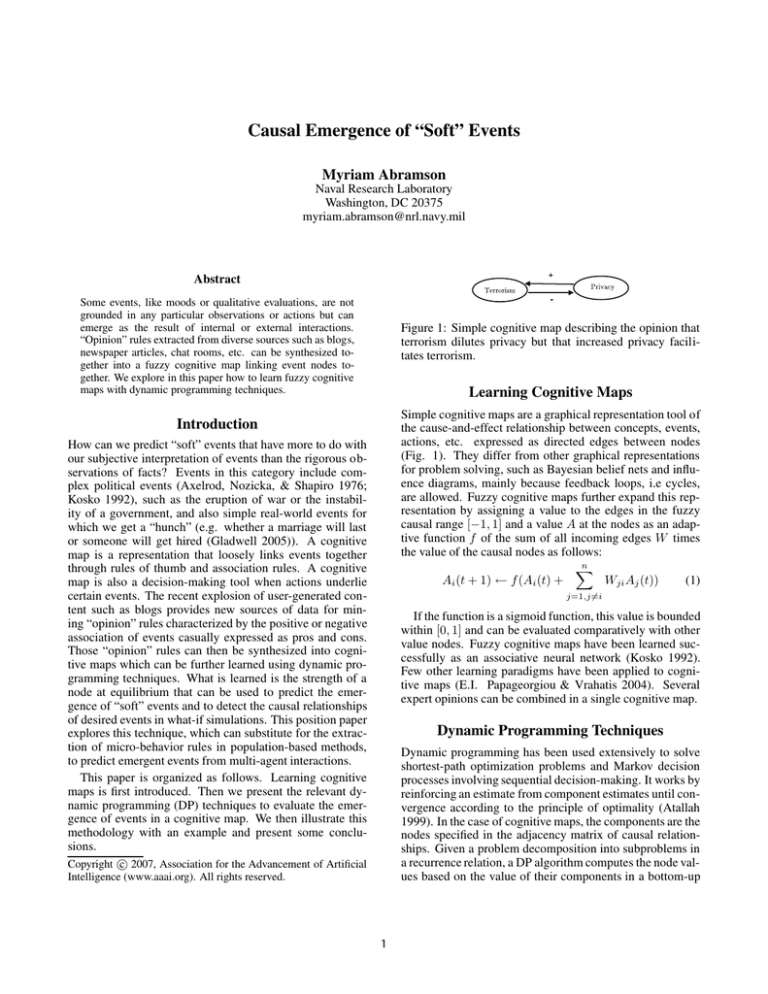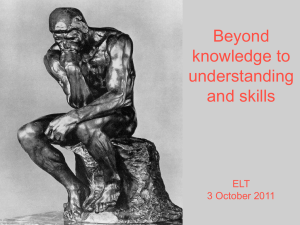
Causal Emergence of “Soft” Events
Myriam Abramson
Naval Research Laboratory
Washington, DC 20375
myriam.abramson@nrl.navy.mil
Abstract
Some events, like moods or qualitative evaluations, are not
grounded in any particular observations or actions but can
emerge as the result of internal or external interactions.
“Opinion” rules extracted from diverse sources such as blogs,
newspaper articles, chat rooms, etc. can be synthesized together into a fuzzy cognitive map linking event nodes together. We explore in this paper how to learn fuzzy cognitive
maps with dynamic programming techniques.
Figure 1: Simple cognitive map describing the opinion that
terrorism dilutes privacy but that increased privacy facilitates terrorism.
Learning Cognitive Maps
Simple cognitive maps are a graphical representation tool of
the cause-and-effect relationship between concepts, events,
actions, etc. expressed as directed edges between nodes
(Fig. 1). They differ from other graphical representations
for problem solving, such as Bayesian belief nets and influence diagrams, mainly because feedback loops, i.e cycles,
are allowed. Fuzzy cognitive maps further expand this representation by assigning a value to the edges in the fuzzy
causal range [−1, 1] and a value A at the nodes as an adaptive function f of the sum of all incoming edges W times
the value of the causal nodes as follows:
n
Ai (t + 1) ← f (Ai (t) +
Wji Aj (t))
(1)
Introduction
How can we predict “soft” events that have more to do with
our subjective interpretation of events than the rigorous observations of facts? Events in this category include complex political events (Axelrod, Nozicka, & Shapiro 1976;
Kosko 1992), such as the eruption of war or the instability of a government, and also simple real-world events for
which we get a “hunch” (e.g. whether a marriage will last
or someone will get hired (Gladwell 2005)). A cognitive
map is a representation that loosely links events together
through rules of thumb and association rules. A cognitive
map is also a decision-making tool when actions underlie
certain events. The recent explosion of user-generated content such as blogs provides new sources of data for mining “opinion” rules characterized by the positive or negative
association of events casually expressed as pros and cons.
Those “opinion” rules can then be synthesized into cognitive maps which can be further learned using dynamic programming techniques. What is learned is the strength of a
node at equilibrium that can be used to predict the emergence of “soft” events and to detect the causal relationships
of desired events in what-if simulations. This position paper
explores this technique, which can substitute for the extraction of micro-behavior rules in population-based methods,
to predict emergent events from multi-agent interactions.
This paper is organized as follows. Learning cognitive
maps is first introduced. Then we present the relevant dynamic programming (DP) techniques to evaluate the emergence of events in a cognitive map. We then illustrate this
methodology with an example and present some conclusions.
j=1,j=i
If the function is a sigmoid function, this value is bounded
within [0, 1] and can be evaluated comparatively with other
value nodes. Fuzzy cognitive maps have been learned successfully as an associative neural network (Kosko 1992).
Few other learning paradigms have been applied to cognitive maps (E.I. Papageorgiou & Vrahatis 2004). Several
expert opinions can be combined in a single cognitive map.
Dynamic Programming Techniques
Dynamic programming has been used extensively to solve
shortest-path optimization problems and Markov decision
processes involving sequential decision-making. It works by
reinforcing an estimate from component estimates until convergence according to the principle of optimality (Atallah
1999). In the case of cognitive maps, the components are the
nodes specified in the adjacency matrix of causal relationships. Given a problem decomposition into subproblems in
a recurrence relation, a DP algorithm computes the node values based on the value of their components in a bottom-up
c 2007, Association for the Advancement of Artificial
Copyright Intelligence (www.aaai.org). All rights reserved.
1
fashion. Dynamic programming is a brute-force approach
since it needs to compute all node values and not just the
relevant ones in order to arrive at an exact solution and the
challenge is to scale up through approximate solutions. For
example, the DP equation to compute the largest set of subtrees through node i with children C(i) is as follows:
L(i) ← max (1 +
i ⊂C(i)
L(i ))
(2)
In stochastic dynamic programming, the transition between nodes is uncertain, reflecting the confidence of an associative “opinion” rule that one event A implies another
event B computed as the conditional probability of event B
relating A∩B
in a text mining
given event A, that is #texts
#texts relating A
context. The cognitive map equation (Eq. 1) is a stochastic DP equation given PijW the probabilities from node i to
node j in the opinion set W where rij reflects whether Ai is
favorable to Aj (±1).
Ai (t + 1) ← f (Ai (t) +
n
PijW rij Aj (t))
Figure 2: Counter-insurgency cognitive map and influence
Iter
(3)
j=1,j=i
The key differences from fuzzy cognitive maps and temporal associative memories (Kosko 1992) are that (1) the
links express probabilistic non-determinism in the causal relationships between nodes rather than fuzziness and (2) that
Monte Carlo simulations rather than neural network “tuning” lead to the inference of future events. In a Monte Carlo
simulation, Ai (t + 1) is approximated as a moving average
based on a random sample and modulated by the learning
rate α:
C1/
C7/
C1/
C7/
C1/
C8
C8
C4
C4
C8+C4
C7/
C8+C4
1
0
0
0
0
0
0
2
0
0
0
0
0
0
3
1.0
0
0
0
0.720
-0.503
4
2.25
0
0
0
1.76
-0.0156
5
2.25
-0.0063
0
0
2.97
-0.0303
6
3.37
-0.0175
0
0
4.18
-0.047
7
3.36
-0.0265
0
0
4.17
-0.0594
8
3.36
-0.0365
-0.0125
0
4.16
-0.0676
9
4.02
-0.0432
-0.0193
0.0005
4.82
-0.0723
10
4.02
-0.0471
-0.0193
0.0005
4.81
-0.0723
Table 1: DP cognitive map evaluation (multiplied by 104 ) of
Fig. 2 (α = 0.01)
the feedback loop property of cognitive maps and their predictive power of “soft” events as well as identify the tipping
points necessary to influence a course of events. This claim
was illustrated with an example of a synthesized cognitive
map from manually extracted opinions on recent events.
Ai (t + 1) ← (1 − α)Ai (t) + α arg samplej PijW rij Aj (t)
(4)
Illustration
References
Figure 2 shows a cognitive map for a counter-insurgency
doctrine extracted from a recent opinion article (Fick 2007)
on the current situation in Afghanistan. The cycles (e.g.,
C4, C5, C6, C7, C4) express the paradoxes of this problem.
Table 1 shows the evaluations of nodes C1 and C7 using
DP (Eq. 4) with the cognitive map of Fig. 2 and successively “clamping” C8 (Infrastructure), C4 (Force Protection)
and combined C8 and C4. The hyperbolic tangent function
bounds node values in the [-1,1] range. The results show
the paradox described in the article, namely, how insurgency
increases with an increase in Force Protection without establishing legitimacy for the government. Combining Force
Protection with increased Infrastructure (C4+C8) produces
the best results according to this cognitive map.
Atallah, M. J., ed. 1999. Algorithms and Theory of Computation Handbook. CRC Press LLC.
Axelrod, R.; Nozicka, G. J.; and Shapiro, M. J., eds. 1976.
The Structure of Decision: The Cognitive Maps of Political
Elites. Princeton University Press.
E.I. Papageorgiou, K.E. Parsopoulos, P. G., and Vrahatis,
M. 2004. Fuzzy cognitive maps learning through swarm
intelligence. In Fuzzy Systems and their Applications, volume 3070 of Lecture Notes in Computer Science. SpringerVerlag. 344–349.
Fick, N. 2007. To defeat the taliban – fight less, win more.
The Washington Post. 08/12/2007.
Gladwell, M. 2005. Blink: The power of Thinking without
thinking. Little, Brown and Company.
Kosko, B. 1992. Neural Networks and Fuzzy Systems.
Prentice Hall, Englewood Cliffs, NJ.
Conclusions
Of course, opinions are just opinions and do not guarantee the accuracy of scientific determinism. However, in the
broader sociological context, opinions can influence behavior and consequently the course of events. They can be selffullfilling prophecies. Dynamic programming can preserve
2





